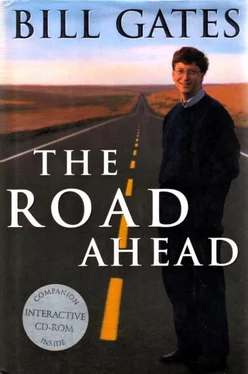We worked extremely hard to make sure our operating-system work with IBM succeeded. I felt the project would be a ticket to the future for both companies. Instead, it eventually created an enormous rift between us. A new operating system is a big project. We had our team working outside Seattle. IBM had teams in Boca Raton, Florida; Hursley Park, England; and later Austin, Texas.
But the geographical problems were not as bad as those that came from IBM’s mainframe legacy. IBM’s previous software projects almost never caught on with PC customers precisely because they were designed with a mainframe customer in mind. For instance, it took three minutes for one version of OS/2 to “boot” (to make itself ready for use after it was turned on). That didn’t seem bad to them, because in the mainframe world, booting could take fifteen minutes.
IBM, with more than 300,000 employees, was also stymied by its commitment to company-wide consensus. Every part of IBM was invited to submit Design Change Requests, which usually turned out to be demands that the personal-computer-system software be changed to fit the needs of mainframe products better. We got more than 10,000 such requests, and talented people from IBM and Microsoft would sit and discuss them for days.
I remember change request #221: “Remove fonts from product. Reason: Enhancement to product’s substance.” Someone at IBM didn’t want the PC operating system to offer multiple typefaces because a particular IBM mainframe printer couldn’t handle them.
Finally it became clear that joint development wasn’t going to work. We asked IBM to let us develop the new operating system on our own and license it to them cheaply. We’d make our profit by selling the same thing to other computer companies. But IBM had declared that its own programmers had to be involved in the creation of any software it considered strategic. And operating-system software clearly was that.
IBM was such a great company. Why should it have so much trouble with PC software development? One answer was that IBM tended to promote all their good programmers into management and leave the less talented behind. Even more significant, IBM was haunted by its successful past. Its traditional engineering process was unsuitable for the rapid pace and market requirements of PC software.
In April 1987, IBM unveiled its integrated hardware/software, which was supposed to beat back imitators. The “clone-killer” hardware was called PS/2 and it ran the new operating system, OS/2.
The PS/2 included a number of innovations. The most celebrated was the new “microchannel bus” circuitry, which allowed accessory cards to connect to the system and permitted the PC hardware to be extended to meet such particular customer requirements as sound or mainframe communications capabilities. Every compatible computer included a hardware-connection “bus” to allow these cards to work with the PC. The PS/2’s Microchannel was an elegant replacement for the connection bus in the PC AT. But it solved problems that most customers didn’t have. It was potentially much faster than the PC AT’s bus. But in actual practice the speed of the bus hadn’t been holding anyone up, and therefore customers couldn’t get much benefit from this newly available speed. More important, the Microchannel didn’t work with any of the thousands of add-in cards that worked with the PC AT and compatible PCs.
Ultimately, IBM agreed to license the Microchannel, for a royalty, to manufacturers of add-in cards and PCs. But by then a coalition of manufacturers had already announced a new bus with many of the capabilities of the Microchannel but compatible with the PC AT bus. Customers rejected Microchannel in favor of machines with the old PC AT bus. The complement of accessory cards for the PS/2 never came close to the number available for PC AT-compatible systems. This forced IBM to continue to release machines that supported the old bus. The real casualty was that IBM lost control of personal-computer architecture. Never again would they be able to move the industry singlehanded to a new design.
Despite a great deal of promotion from both IBM and Microsoft, customers thought OS/2 was too unwieldy and complicated. The worse OS/2 looked, the better Windows seemed. Because we’d lost the chances both for compatibility between Windows and OS/2, and for OS/2 to run on modest machines, it still made sense to us to continue to develop Windows. Windows was far “smaller"—meaning it used less hard-disk space and could work in a machine with less memory, so there would be a place for it on machines that could never run OS/2. We called this the “family” strategy. In other words, OS/2 would be the high-end system and Windows would be the junior member of the family, for smaller machines.
IBM was never happy about our family strategy, but it had its own plans. In the spring of 1988, it joined other computer makers in establishing the Open Software Foundation to promote UNIX, an operating system that had originally been developed at AT&T’s Bell Labs in 1969 but over the years had splintered into a number of versions. Some of the versions were developed at universities, which used UNIX as a working laboratory for operating-systems theory. Other versions were developed by computer companies. Each company enhanced UNIX for its own computers, which made their operating system incompatible with everyone else’s. This meant that UNIX had become not a single open system, but a collection of operating systems competing with one another. All the differences made software compatibility harder and held back the rise of a strong third-party software market for UNIX. Only a few software companies could afford to develop and test applications for a dozen different versions of UNIX. Also, computer-software stores couldn’t afford to stock all the different versions.
The Open Software Foundation was the most promising of several attempts to “unify” UNIX and create a common software architecture that would work on various different manufacturers’ hardware. In theory, a unified UNIX could get a positive-feedback cycle going. But despite significant funding, it turned out to be impossible for the Open Software Foundation to mandate cooperation from a committee of vendors who were competing for each sale. Its members, including IBM, DEC, and others, continued to promote the benefits of their particular versions of UNIX. The UNIX companies suggested their systems would benefit customers by offering them more choices. But if you bought a UNIX system from one vendor, your software couldn’t automatically run on any other system. This meant you were tied to that vendor, whereas in the PC world you have a choice of where to buy your hardware.
The problems of the Open Software Foundation and similar initiatives point up the difficulty of trying to impose a standard in a field in which innovation is moving rapidly and all the companies that make up the standards committee are competitors. The marketplace (in computers or consumer electronics) adopts standards because customers insist on standards. Standards are to ensure interoperability, minimize user training, and of course foster the largest possible software industry. Any company that wants to create a standard has to price it very reasonably or it won’t be adopted. The market effectively chooses a reasonably priced standard and replaces it when it is obsolete or too expensive.
Microsoft operating systems are offered today by more than nine hundred different manufacturers, which gives customers choices and options. Microsoft has been able to provide compatibility because hardware manufacturers have agreed not to allow modifications to our software that introduce incompatibility. This means that hundreds of thousands of software developers don’t need to worry about what PCs their software will run on. Although the term “open” is used in many different ways, to me it means offering choice in hardware and software applications to the customer.
Читать дальше











